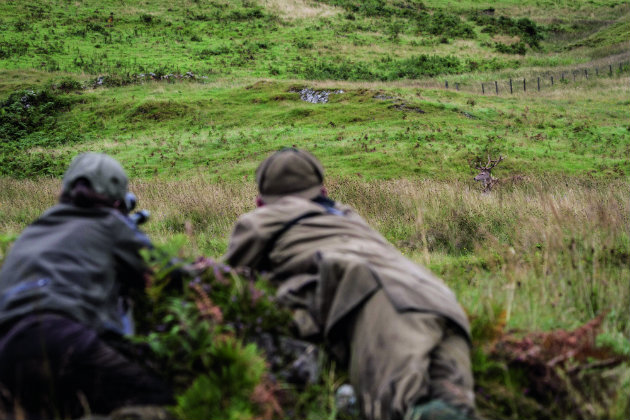Steps to a successful stalk
In the second of this two-part feature, Niall Rowantree looks at how to approach a deer stalk on the hill, what kit to take and which deer to select

Movement and your outline are what the deer will see, so use the natural topography to hide your approach
In the first part of this feature – How to think like a deer – I looked at why considering how a deer uses its senses, and how this can impact on its behaviours, can help to make you a successful stalker. So, bearing this in mind, how can this inform your stalking in practice?
Every stalker knows to stay downwind of his quarry. I work at an angle to the wind, as this gives me more flexibility to change my course. Not only that, but walking straight into the wind impairs our senses, so you will stand more chance of finding animals if you work at an angle to the wind.

Beware of swirling winds, such as you find in valleys, woodland or corries. If you are working up a corrie, the wind is not true, and you can find that your quarry has caught your scent and you’ve inadvertently chased them off.
When stalking avoid walking along skylines
There are plenty of stalkers who, once they have planned an outing, insist on going out whatever the weather. However, consider what the deer will be doing. If they cannot rely on their senses to inform them of predators, they will be edgy and nervous, moving from place to place. Disturb them during this weather, and you will make them skittish for a few days. It is far better to wait until the poor weather has improved.

When you are stalking in the hills, avoid walking along skylines
Movement and your outline is what deer will see. When stalking in the hills, this means avoiding walking along skylines and using the natural topography to hide your approach. With woodland stalking, you need to be mindful that deer are often at the edges of woodland, so your approach should reflect that. Walking too close to the woodland’s edge will most likely push the deer deeper into woodland.
If you have spotted a herd or a deer on the hill, the approach is all-important. It can be easy to lose sight of the animals you are stalking as you pick your way around dead ground and the rises and falls of the territory. Pick four reference points to the deer and use them to maintain your bearings. Make sure they are easy to identify from different angles. Remember that there may be more animals between you and your identified quarry, so go slow. A few very experienced stalkers will be able to move the deer out of their path without causing their quarry to flee.
Niall’s top tips for deer stalking
Use natural features to mask your approach. A bubbling stream can hide the sound of your footsteps in woodland across dried leaves, for example.
- Do remember, stalking is not about looking good. Wear loose-fitting clothing of the right colour for the area you are stalking in. Tight clothes will make your outline more visible, and remember that certain clothes will go darker in the rain, thus making you very visible.
- Don’t jump across burns or other obstacles. First and foremost, you will be putting yourself at risk of injury, and the vibrations may well warn deer that there is danger nearby.
- Wear proper hill-walking boots to protect your ankles and give you grip.
- When stalking in the uplands, pick four obvious reference points around the deer you are stalking and use these to close in on your quarry.
- Wear gloves and a peaked cap, particularly at dawn and dusk.
- Take a stick with you. It’s a third leg.
The ethical dos and don’ts
It’s easy, in the heat of the moment, to forget some of the tenets that should govern every decision we make as stalkers. We are all ambassadors for what we do, and we are under ever-increasing public scrutiny. First on every stalker’s agenda should be the humane treatment of deer.
- Always take youngsters first: if you shoot the dam first, you risk leaving the youngster to fend for itself. This is especially true of deer that herd, as the herd may run after the first shot, taking the youngster with it.
- When culling females, be selective. The hind/doe cull is about reducing numbers, but taking the right beasts is equally important.
- Don’t shoot deer if they are close to the skyline — if they run, you will lose them. The same goes for shooting beasts across a body of water, or anywhere that you may not be able to follow up with ease and in good time.
- Only shoot matriarchs if there is a good reason to (health or age). They are important for the herd’s well-being, as they are the ones who will lead the herd to good food sources and shelter.
- Cull early in spring when cover is low. You will be able to spot more deer, thus be more selective, and you will be able to follow up easily.
- Don’t shoot the first deer you come across, do shoot any deer that don’t look healthy.
- Don’t shoot at long distances unless you have no other options.
- Make sure you feel confident of the shot and have a good steady shooting position.
What sort of deer stalking rifle should I buy?
Our expert at Sporting Gun advises: A: Well, your budget is decent. That’s good news because a suitable rifle with…
Step by step: Bullets for deer stalking
Deer stalking: People often spend hours pondering over which rifle, grade of wood and scope they want to buy, but…










